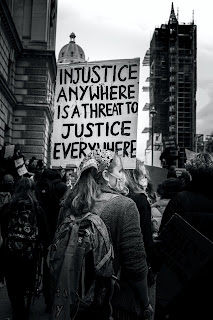Day 2 - Resisting the uncritical acceptance of fragmented truth
Day 2: From Toni Cade Bambara (1980/2000):
Writing is one of the ways I participate in transformation - one of the ways I practice the commitment to explore bodies of knowledge for the usable wisdoms they yield. In writing, I hope to encourage the fusion of those disciplines whose split (material science versus metaphysics versus aesthetics versus politics versus...) predisposes us to accept fragmented truths and distortions as the whole. (p. 154)
This quote from Bambara's essay, What it is I think I'm doing anyhow, spoke to me about the disciplinary splits within the creative arts therapies. How does expressive arts therapy define itself? Are we yet another "specialization" within the creative arts therapies? Can expressive arts therapy serve a function as a unifying force, or at least a reminder of the dangers of fragmentation and distortion so prevalent within our highly specialized culture?
Lesley University's expressive therapy program began during a time of experimentation and with a desire to transcend specialization. For McNiff (2004), art therapy involved working with all of the arts, and this approach meant “working with everything we have” (p. 168). The Expressive Therapies program at Lesley University began over 40 years ago based on the vision of an integrative approach to the arts as therapy.
The founders of this program recognized the inherent underlying common factors that serve to unite the various expressions of the arts as therapy: creativity, non-verbal modes of expression, embodied aesthetics, sensory-based experience, and action-oriented forms of therapy. They had a vision of educating all expressive therapists from a multi-modal foundation (using all the arts), not only just as art therapists, dance therapists, drama therapists, or music therapists, but also as expressive therapists able to move intuitively and intentionally from one art form to another. The degree title until 2015 for all students was a Masters in Expressive Therapies. Some students embraced this integrative arts approach as their primary identity while others embraced their single art form as their primary identity.
As the program progressed however, and as the pressures to integrate mental health counseling into a core identity for students increased, specialization tracks (art therapy, dance therapy, music therapy, and drama therapy) became more pronounced and more regulated by professional associations and credentialing bodies. This multi-modal foundation has become questionable.
The impulse to "fuse" these disciplines, and to see a value in a (w)holistic approach to the arts therapies, is becoming harder to accept. Our specializations "predispose us to accept fragmented truths and distortions as the whole." One of the questions I am asking myself during this sabbatical is how do we redefine ourselves as expressive arts therapists? What role does expressive arts therapy play in the increasing critical perspective each of the arts therapies is taking with itself? What needs to die in expressive arts therapy in order to be reborn and take its place within the landscape of healing and social justice (Norris, 2020)?
Bambara, T. C. (1980/2000). What it is I think I'm doing anyway. In J. Sternberg (Ed.), The writer on her work (pp. 153-168). WW Norton & Co.
McNiff, S. (2004). Art heals: How creativity heals the soul. Shambhala Publications, Inc.
Norris, M. S. (2020). Freedom dreams: What must die in music therapy to preserve human dignity? Voices, 20(3). https://doi-org.ezproxyles.flo.org/10.15845/voices.v20i3.3172




Comments